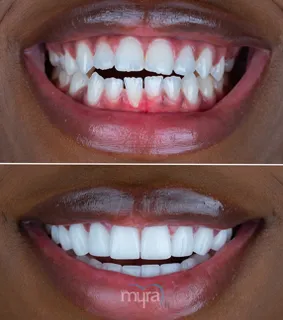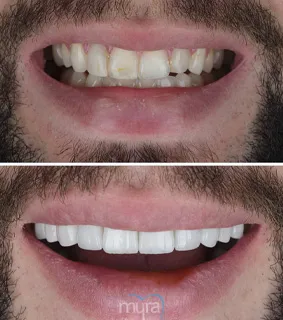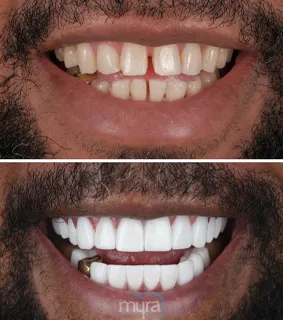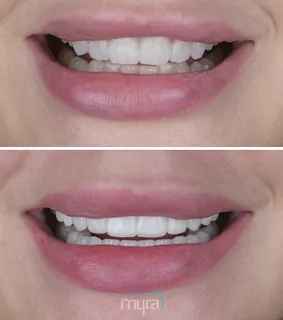Enamel shaping, or contouring, is a cosmetic dental procedure that entails precisely modifying tooth enamel to improve its appearance. Enamel shaping aims to make minor adjustments to the teeth's contour, length, or surface, resulting in a more beautifully appealing and balanced smile. Dentists correct problems, including uneven or malformed teeth, tiny overlaps, or rough edges, by eliminating a little enamel.
The advantage of enamel shaping is its conservative character since it is a minimally invasive surgery. Anaesthetic is usually unnecessary, and there is minimal discomfort or suffering. Enamel shaping is often finished in a single dental arrangement, giving rapid results and needing minimal recuperation time. Enamel shaping is a reasonably fast and affordable alternative to other cosmetic dentistry operations for enhancing the look of the teeth.
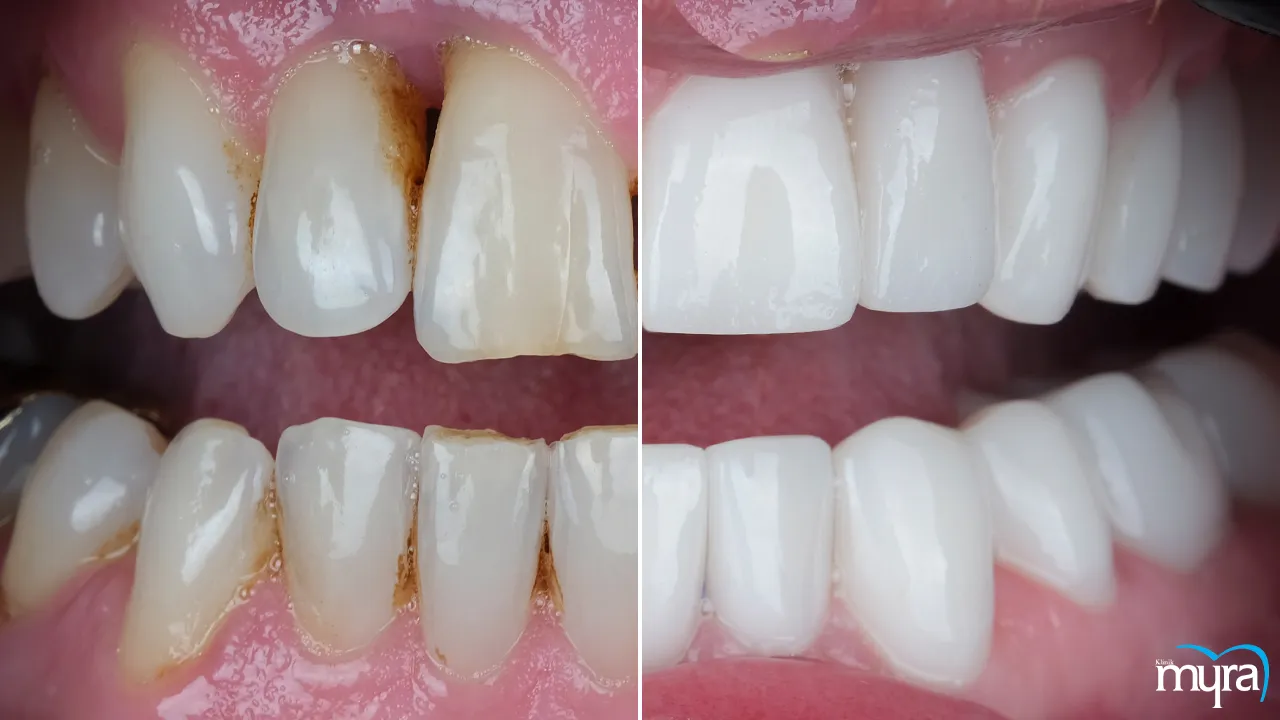
Enamel shaping mainly serves cosmetic purposes, attempting to improve the overall appearance of the teeth and provide a more aesthetically pleasing smile. It is appropriate for patients with mild dental flaws, including slightly misaligned or malformed teeth. Enamel shaping, however, must not be used to treat severe dental conditions such as tooth decay, structural damage, or severe misalignment. Alternative procedures like veneers, dental bonding, or orthodontics are suggested.
Enamel shaping is often less expensive than other cosmetic dentistry treatments when it comes to cost. The precise price varies based on several variables, including the dentist's experience, where they are practising, the degree of enamel shaping needed, and any extra treatments included in the operation. Speaking with a dental expert who provides a customised evaluation and reviews the exact costs is recommended.
What is Enamel Shaping?
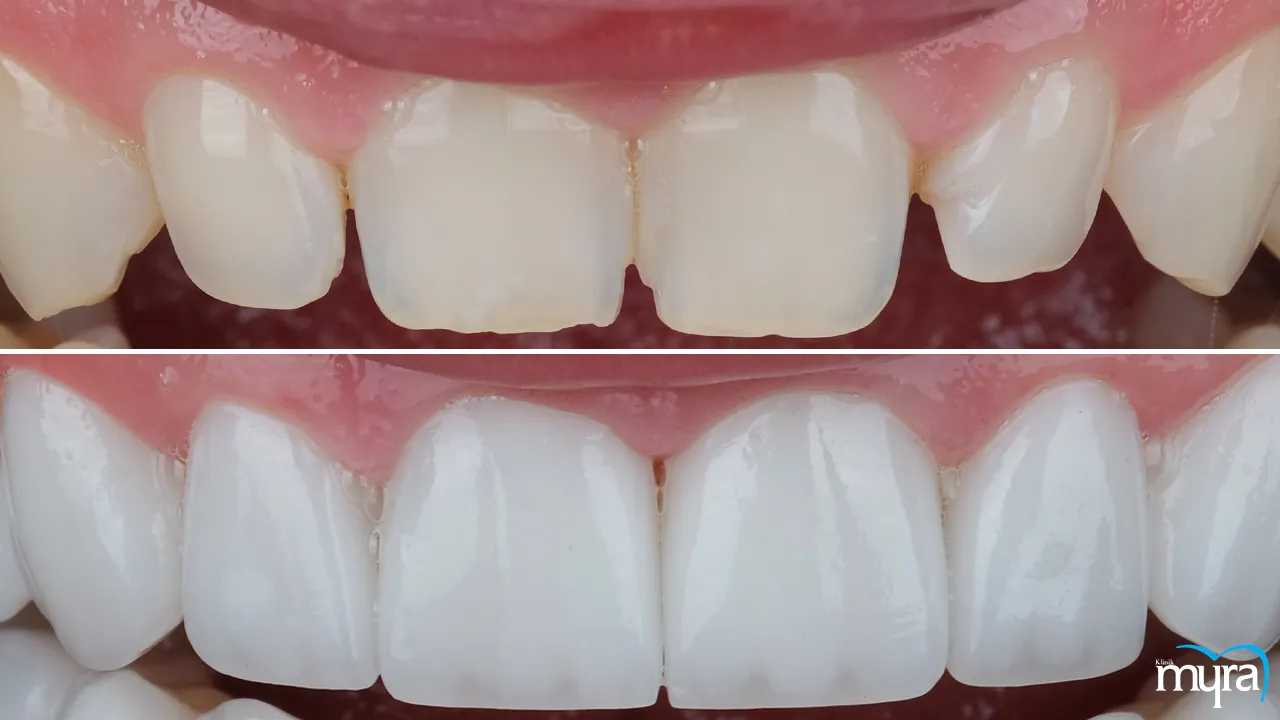
Enamel shaping, called enameloplasty or contouring, is a cosmetic dentistry operation that removes or reshapes tiny parts of tooth enamel. Enamel shaping is a procedure in which the dentist softly sculpts the tooth's outer covering to enhance its look. The dentist adjusts the tooth's form, size, or surface contour by gently pulling or sculpting the enamel. The operation is used to correct minor aesthetic issues such as uneven tooth forms, rough edges, or tiny overlaps between teeth. The method is less invasive and aids in creating a more harmonious and aesthetically attractive smile. It is coupled with other aesthetic dental approaches to provide the best results.
How does Enamel Shaping Work?
Listed below are the seven steps on how enamel shaping works.
- Assessing the teeth. The first step is to undergo a comprehensive dental examination. The dentist examines the patient’s teeth to see whether enamel shaping suits them. They examine the tooth size, shape, alignment, and the overall oral health.
- Taking x-rays if necessary. The dentist takes X-rays in certain circumstances to check the underlying architecture of the teeth and confirm no abnormalities that interfere with the enamel shaping operation.
- Planning the treatment. The dentist talks with the patient about the modifications they want to make and comes up with a treatment plan after it is decided that enamel shaping is acceptable for the teeth. The blueprint specifies which sections of the enamel must be shaped.
- Administering local anaesthesia. Enamel shaping is usually a painless operation, but if the tooth is sensitive or the dentist expects the need to remove a substantial quantity of enamel, they administer local anaesthesia to numb the region.
- Contouring the enamel. The dentist gently removes tiny bits of enamel from the desired locations using a dental drill or other specialised devices. Smoothing rough edges, straightening pointed or uneven teeth, or altering the length or breadth of certain teeth are all part of the procedure. The dentist sticks to the treatment plan to get the desired result.
- Polishing the teeth. The dentist uses a delicate dental polishing instrument to smooth the treated teeth's surface once the enamel has been shaped. The technique contributes to a more natural and finished look.
- Scheduling a follow-up appointment. The dentist recommends oral hygiene and maintenance once the enamel shaping process is finished. They set up a follow-up session to assess the findings and make any required changes.
What is the Cost of Enamel Shaping?
The cost of enamel shaping varies based on several variables, including the procedure's intricacy, the dentist's skill, the region, and the individual dental facility. However, it is often seen as a cheaper cosmetic dental treatment compared to other operations like veneers or orthodontic treatments.
Enamel shaping costs between £38.20 and £229.19 per tooth on average. The price usually includes the dental exam, X-rays (if necessary), the enamel reshaping process, and follow-up sessions. Remember that it is an approximate estimate, and costs vary greatly.
Talking to a doctor or dental centre is the best way to know how much teeth reshaping costs. They assess the unique dental requirements, provide a thorough treatment plan, and present a suitable quote for the circumstances.
What is the purpose of Enamel Shaping?
Enamel shaping serves several purposes and is pursued for a myriad of reasons. The primary purpose of enamel shaping is to enhance the look of the teeth. People often seek enamel shaping to resolve minor cosmetic difficulties that impair their smile's harmony and beauty.
Fixing uneven tooth edges or removing minor chips or flaws in the enamel is one of the most frequent reasons for enamel shaping. Such abnormalities cause the teeth to seem jagged or rough, damaging the smile's overall symmetry and balance. A dentist straightens and contours the teeth by gently removing tiny portions of enamel, resulting in a smoother and more uniform look.
Enamel shaping is advantageous for patients who have pointed or abnormally long teeth. A more balanced and aesthetically attractive smile is obtained by carefully altering the form and length of these teeth. Enamel shape enhances the teeth' look with slight overlaps or defects on the tooth surface.
Enamel shaping is a more conservative and less expensive option than other cosmetic dental treatments such as veneers or orthodontic procedures. It is a fast and painless procedure that provides visible effects in a single dentist appointment.
Enamel shaping has limits. It is inappropriate for treating major dental issues such as crooked teeth, huge gaps, or extreme discolouration. A dentist proposes alternate therapies in such circumstances. Individuals with minor cosmetic flaws find enamel shaping a cost-effective and non-invasive way to improve their smile and self-confidence.
Who is Eligible to take Enamel Shaping?
Enamel shaping is eligible for individuals with particular dental conditions. Enamel shaping is a cosmetic dentistry operation that is appropriate for patients who have specific dental problems. The eligibility for enamel shaping is typically determined by a dentist following a comprehensive exam. People with modest aesthetic problems and a desire for slight enhancements to their smile are often ideal candidates for enamel shaping.
Enamel shaping helps people with uneven front teeth, where some teeth seem longer than others or have jagged edges. The process assists in generating a more balanced and consistent grin by gently rearranging the enamel to obtain a harmonious look.
Individuals with small chips or surface flaws on their teeth benefit from enamel shaping. The dentist smooths out the irregularities and enhances the overall appearance of the damaged teeth by delicately removing a bit of enamel.
Enamel shape is advantageous for patients who have sharp tooth corners, which give their teeth an unduly pointed or jagged look. The dentist shapes and rounds sharp edges to create a more visually attractive smile.
What are the Advantages of having Enamel Shaping Treatment?
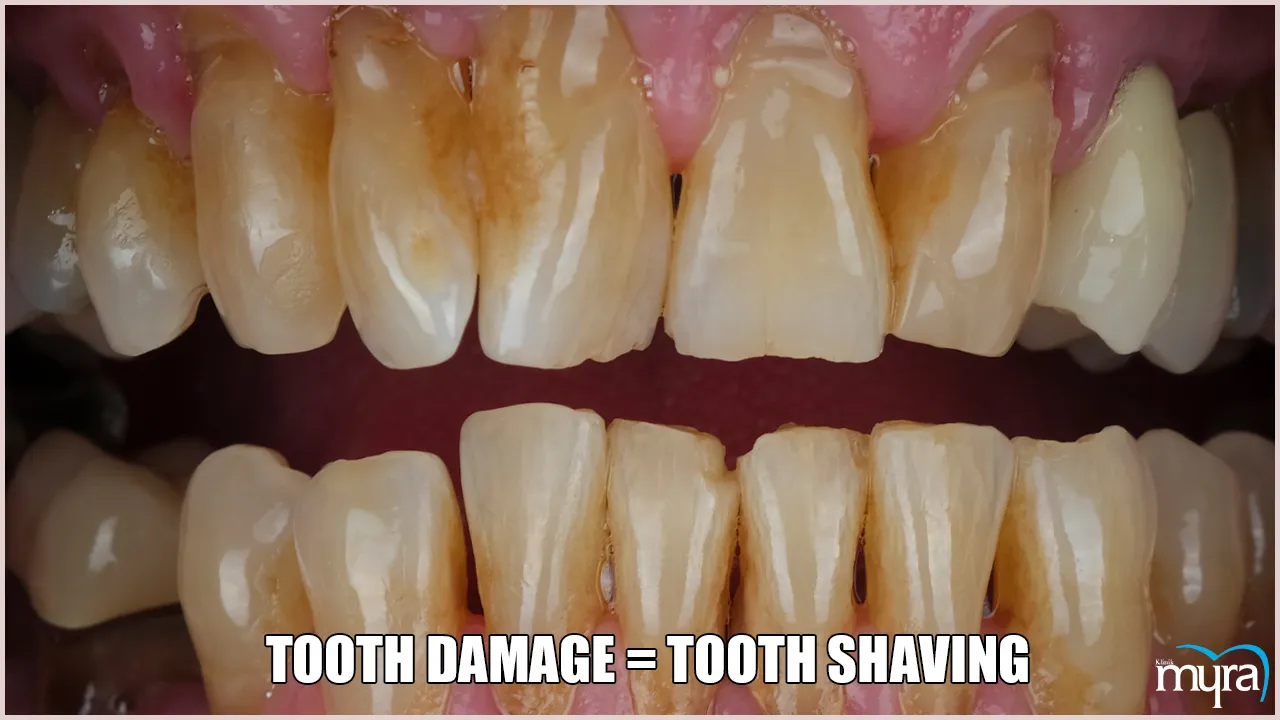
Enamel shaping treatment, also known as enamel contouring or dental reshaping, offers several advantages for individuals looking to improve the appearance of their teeth. Let's explore these advantages in detail:
Quick procedure:
Enamel shaping is a relatively simple and fast procedure that can often be completed in a single dental appointment. The results are instant, providing immediate improvements to the appearance of the teeth.
Example: Dentists can quickly reshape damaged or uneven tooth edges, enhancing the overall symmetry of the smile in a short amount of time.
Preserves natural tooth structure:
During enamel shaping, dentists aim to remove as little enamel as possible while still achieving the desired cosmetic effect. This preservation of natural tooth structure ensures the long-term health and integrity of the teeth.
Example: Dentists can change the shape of teeth, addressing minor irregularities, without compromising their strength and overall dental health.
Cosmetic enhancement:
Enamel shaping can significantly enhance the appearance of the teeth, resulting in a more harmonious and balanced smile. It is particularly beneficial for individuals with minor cosmetic concerns.
Example: Uneven front teeth can be reshaped to provide a more uniform and aesthetically pleasing smile.
Non-invasive:
Enamel shaping is a minimally invasive dental procedure. It involves removing only tiny portions of enamel, and in many cases, it does not require the use of anesthesia or drilling.
Example: Dentists can smooth sharp tooth corners or adjust minor imperfections without the need for extensive dental work or discomfort.
Cost-effective:
Compared to other cosmetic dental procedures like veneers or orthodontics, enamel shaping is often more affordable, making it an accessible option for individuals seeking cosmetic enhancements.
Example: Opting for enamel shaping can be a cost-effective method of improving the appearance of the teeth, especially for those with minor cosmetic issues.
Enamel shaping has various benefits, including aesthetic improvement, a non-invasive method, a rapid process, cost-effectiveness, and the preservation of natural tooth structure. The advantage enamel shaping has made it an intriguing alternative for anyone looking for small aesthetic changes to their teeth. Choosing an enamel shape as a therapy results in a more visually attractive smile while preserving the original teeth's integrity.
What are the Disadvantages of not having Enamel Shaping Treatment?
Not opting for enamel shaping treatment can have several disadvantages that individuals should consider when making decisions about their dental care. Let's explore these disadvantages in detail:
Irreversible Procedure:
Enamel shaping involves the permanent removal of a small amount of enamel from the teeth. Once the enamel is contoured, it cannot be replaced. This makes enamel shaping an irreversible procedure.
Examples: If an individual undergoes enamel shaping and later experiences dental issues or changes their mind about the treatment, it is not possible to restore the original enamel that was removed.
Limited Scope of Treatment:
Enamel shaping is suitable only for addressing minor cosmetic issues, such as slight irregularities or minor overlaps. It is not an effective treatment for more severe dental problems like significant misalignment or large gaps between teeth.
Examples: Enamel shaping cannot correct crooked teeth or major gaps, and other treatments like orthodontics or dental veneers may be necessary to address these issues effectively.
Tooth Sensitivity:
Enamel shaping involves the removal of a small portion of enamel, which can lead to increased tooth sensitivity. The affected teeth may become more sensitive to hot or cold stimuli.
Examples: Consuming ice-cold beverages or hot foods after enamel shaping can cause temporary dental sensitivity or discomfort.
Risk of Enamel Damage:
In rare cases, there is a risk of either excessive enamel removal or insufficient contouring during the shaping process. This can result in weaker teeth or uneven tooth surfaces.
Examples: If a dentist removes too much enamel during the shaping procedure, it may weaken the tooth's structure or create an uneven appearance.
Overall, while enamel shaping offers certain cosmetic benefits, it is not a suitable treatment for all dental concerns. Individuals should seek advice from a dental expert to determine if enamel shaping is the best course of action based on their specific dental needs and goals. It is essential to weigh the potential disadvantages of enamel shaping, despite its benefits, and consider alternative treatments if necessary. A comprehensive dental evaluation can help individuals make informed decisions about their dental care options.
What are the Side effects of Enamel Shaping?
There are potential side effects associated with enamel shaping similar to any dental treatment, although it is usually considered safe and less invasive. Be aware of such side effects, even though they are usually minor and short-lived.
Tooth sensitivity is one potential adverse effect of enamel shaping. A temporary increase in sensitivity to heat and cold stimuli results from removing enamel, the protective coating of the tooth, during the shaping process. Its increased sensitivity usually disappears within a few days or weeks as the tooth adapts.
Another side effect is moderate discomfort or pain during or after the surgery. Some people feel irritation or pain in the treated region. It is usually a minor annoyance alleviated with over-the-counter pain medications or sensitivity toothpaste. Call the dentist if the discomfort worsens or remains.
Excessive enamel removal or an ineffective shaping approach results in unexpected outcomes such as uneven tooth surfaces, chipping, or rough edges in rare situations. However, such complications are avoided when performed by an experienced dentist.
Discuss any concerns or potential side effects with the dentist before undergoing enamel shaping. Maintaining open lines of communication with the dentist is crucial for addressing any queries or worries patients have, including any possible negative consequences of the surgery. Patients acquire a thorough grasp of the operation and determine if enamel shaping is the best option for them by asking questions like "What are the side effects of enamel shaping?"
What is the procedure performed in Enamel Shaping?
The process of shaping the enamel includes a few key steps that change the shape and look of the teeth. The primary steps in enamel shaping are evaluation, planning, contouring, and polishing.
The first step in making enamel is figuring out what needs to be done. A dentist thoroughly inspects teeth, considering tooth size, shape, alignment, and oral health. Dentists review the patient’s concerns and modifications to evaluate whether enamel shaping suits them.
The dentist starts the planning phase when the evaluation is over. They develop a treatment plan that specifies the particular sections of enamel that must be sculpted and reshaped. The strategy takes the desired result, tooth proportions, and overall smile attractiveness into consideration.
The next stage is contouring, which involves the dentist reshaping the enamel. The dentist gently removes tiny bits of enamel from specified places using specialised dental devices such as a dental drill or abrasive strips. Smoothing rough edges, straightening pointed or uneven teeth, or altering the length or breadth of certain teeth are all part of the procedure. The dentist adheres to the treatment plan to provide exact and balanced outcomes.
The dentist moves on to the polishing step after contouring the enamel. They smooth and improve the surface of the treated teeth using a precise dental polishing instrument. The phase assists in achieving a natural and polished look, which improves the overall esthetics of the teeth.
The dentist assures comfort during the operation and uses local anaesthetic if necessary; however, enamel shaping usually is a painless procedure. They provide post-treatment care recommendations, including basic dental hygiene habits and suggestions for sustaining the effects of enamel shaping.
How many years does Enamel Shaping last?
The duration of enamel contouring varies from person to person and depends on some variables. Enamel shaping is usually a long-lasting operation, but there is no clear answer as to how many years it endures. Individual oral hygiene habits, lifestyle decisions, and general dental health are all variables that affect how durable enamel shaping is.
Enamel shaping endures for many years if properly cared for and maintained. People aid in maintaining the benefits of enamel shaping and extending its longevity by engaging in appropriate oral hygiene practices, such as consistent brushing, flossing, and dental examinations.
Results of enamel shaping are considered permanent since enamel does not renew after it has been removed. The durability of the operation is impacted by just natural wear and tear, oral trauma, or other dental problems. Additional dental procedures or touch-ups are required in certain circumstances to retain the ideal cosmetic look.
Is Dental Procedure for Enamel Shaping Painful?
No, the dental procedure for enamel shaping is not painful. Small portions of enamel are removed during enamel shaping, a minimally invasive cosmetic dentistry surgery, to enhance the look of a tooth. Dental tools like sanding discs or tiny diamond burs, which gently modify the enamel, are often used during the operation.
Local anaesthetic is often not used during enamel shaping since the treatment is generally painless. Assuring that the dentist sufficiently numbs the tooth and surrounding region helps to reduce any possible sensitivity or pain during the procedure. Pain threshold and sensitivity differ from person to person, which makes it essential to communicate any discomfort to the dentist during the procedure.
Some people feel mild soreness or temporary pain after the enamel shape process. Its sensitivity is often transient and is treated with over-the-counter painkillers or desensitising toothpaste. It is best to discuss any worries or probable pain with the dentist before the surgery, as they provide advice and answer any patient questions.
Is there a limitation in having Enamel Shaping?
Yes, there is a limitation in having enamel shaping. Enamel shape is not suitable for everyone or every dental case. The amount of enamel that has to be reshaped, the underlying dental condition, and the intended result are a few examples of the elements that affect the limitations of enamel shaping.
Enamel reshaping is recommended for minor cosmetic concerns, such as rectifying small fractures, irregular margins, or slightly overlapped teeth. Dental bonding, veneers, or crowns are other procedures that are more suited if there are more serious structural problems or considerable enamel damage.
The quantity of enamel that is safely removed during enamel shaping is restricted. The enamel serves as a crucial layer of protection for the teeth, and its integrity is compromised by excessive removal, increasing sensitivity and raising the possibility of dental issues. Dentists assess the state of the tooth and decide how much enamel is safely altered while maintaining strength and function.
Enamel shaping is inappropriate for patients with specific dental issues or disorders. For example, individuals with substantial tooth decay, tooth fractures, or dental restorations need various procedures to address those conditions before contemplating enamel shaping. Orthodontic therapy, besides simply shaping the enamel, is necessary for patients with significant malocclusion or bite misalignment.
Have reasonable expectations regarding the results of enamel contouring. It enhances a tooth's appearance but not its discolouration, misalignment, or form problems. A mix of therapies is required in such circumstances to get the desired result.
Get the advice of a trained dentist who assesses the patient’s unique dental health, discusses their objectives, and suggests the most suited course of action before deciding if enamel shaping is a viable choice. They assess the limits and possible alternatives to enamel shaping depending on the specific demands and oral health.
What is the difference of Enamel Shaping and Dental Contouring?
Dental contouring and Enamel shaping have different meanings in the dentistry industry. There is little difference between the two approaches, although they are often used interchangeably to describe the same process.
Enamel shaping is the technique of removing tiny quantities of enamel to enhance the aspect of the teeth. It improves the enamel's form, contour, and surface texture. Enamel shaping is intended to make tiny modifications to buff out flaws, such as slightly off-centre or irregularly spaced teeth. It is a conservative method since it requires minimum enamel removal and mainly attempts to enhance the cosmetic attractiveness of the teeth.
Dental contouring is more general and includes sculpting not just the enamel but the dentin and cementum in addition to the enamel. Dental contouring is adjusting the teeth's general structure and form to enhance their look. It handles problems like broken teeth, protruding cusps, or jagged edges. More extensive reshaping and removal of dental material other than enamel is necessary during dental contouring.
The difference between "enamel shaping" and "dental contouring" resides in the extent of the procedure and the dental structures involved. Dental contouring includes remodelling several dental components and requires more substantial changes than enamel shaping, which mainly focuses on the enamel and involves less enamel loss.
Speak with a dental expert to establish the best treatment plan based on individual dental requirements and objectives. The dentist evaluates the condition of the teeth and makes any necessary recommendations, including enamel shaping, dental contouring, and other cosmetic dental procedures.






